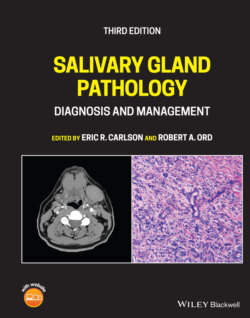Читать книгу Salivary Gland Pathology - Группа авторов - Страница 134
Bacterial Sialadenitis in Pregnancy
ОглавлениеThe female patient with inflammation of any major salivary gland and a superimposed gravid uterus represents a routine clinical diagnostic challenge but a radiographic and treatment dilemma (Figure 3.20). Under such circumstances, the clinician must exert proper judgment in terms of the utility and timing of contrast‐enhanced CT or MRI as well as the administration of oral and intravenous antibiotics. Although evidence‐based guidelines report the safety to the fetus in using iodinated contrast during pregnancy, intravenous gadolinium is contraindicated due to its teratogenicity (Chen et al. 2008). These authors also indicate that the first two weeks of embryogenesis are associated with a risk of blastocyst implant failure when the radiation dose exceeds 0.1 Gy (10 cGy). Further, between the second and twentieth week of embryonic age, the fetus is most susceptible to radiation and its teratogenic sequelae including microcephaly, growth restriction, behavioral defects, cataracts, and others. The precise threshold dose of radiation to the fetus when teratogenicity occurs is estimated to range from 5 to 15 cGy (Chen et al. 2008). Most maxillofacial CT scans that would be ordered to image submandibular and parotid sialadenitis are likely to not exceed this threshold, but individual practitioners are encouraged to confirm such in consultation with their radiology departments. In terms of contrast media for use in CT, iodine has the potential to induce neonatal hypothyroidism, although iodinated contrast media are generally not believed to be teratogenic. Given that it is standard practice to screen all neonates for hypothyroidism, this test is particularly important in neonates of women who underwent iodine contrast CT during pregnancy. In the final analysis, guidelines of the American College of Radiology state that it is not possible to establish definitive conclusions regarding the risks of iodinated contrast use in pregnant women and therefore recommend that such contrast should only be administered if absolutely essential and only after informed consent has been obtained from the patient.
The potential use of MRI in pregnant women with sialadenitis conjures two concerns, including teratogenicity and acoustic damage, although most studies evaluating MRI in pregnant women show no ill effects (Chen et al. 2008). Potential mechanisms for damage of the developing fetus include the heating effect of magnetic resonance gradient changes and direct nonthermal interaction of the electromagnetic field with biological structures. In terms of acoustic damage, loud noises generated by the MRI scanner coils, particularly with echo planar imaging, the noisiest sequence in clinical use, could be deleterious to the developing fetus. Finally, intravenous gadolinium is teratogenic in animal studies, although at high and repeated doses. It is classified as a category C drug by the Food and Drug Administration. Gadolinium crosses the placenta where it is likely excreted by the fetal kidneys into the amniotic fluid. In terms of gadolinium‐induced nephrogenic systemic fibrosis, this raises the theoretical issue of toxicity due to disassociation and persistence of free gadolinium (Chen et al. 2008). As such, gadolinium should be avoided during pregnancy and CT with intravenous contrast should be substituted under proper considerations and judgment.
Figure 3.20. A 21‐year‐old woman (a and b) with a three‐week history of left facial swelling. Her history also divulged a first trimester pregnancy. Conservative measures were accomplished including heat, the use of sour ball candies, massage, and an anti‐staphylococcal antibiotic × one week. She responded incompletely to these conservative measures and a CT scan (c) was obtained during her second trimester of pregnancy. No stone was identified and no surgical intervention was required. The patient ultimately resolved her chronic parotitis (d and e) and she did not experience a recurrent episode.
Antibiotics account for approximately 80% of all medications prescribed during pregnancy and approximately 20–55% of women will receive an antibiotic during pregnancy (Bookstaver et al. 2015). Although the use of an oral or intravenous antibiotic during pregnancy is a risk–benefit decision‐making exercise, any untreated infection is associated with significant fetal risk including spontaneous abortion, low birth rate, and prematurity. That said, antibiotic exposure during pregnancy may result in short‐term and long‐term effects on infant weight, specifically lower birth weight; childhood obesity; neurologic disease, including cerebral palsy and epilepsy; and childhood asthma (Bookstaver et al. 2015).
In addition to fetal safety related to antibiotic use during pregnancy, there are physiologic changes in pregnancy that may lead to pharmacokinetic changes and impact pregnancy. For example, increases in total body water, blood volume (40–50%), and plasma volume (40–50%) contribute to increases in volume of distribution of various antibiotics. Renal blood flow increases by 50%, serum creatinine decrease, and glomerular filtration rate increases elimination of renally excreted antibiotics. Changes in gastrointestinal motility may alter absorption, oral bioavailability, and delayed onset of action of certain antibiotics. The beta‐lactam antibiotics, vancomycin, metronidazole, and clindamycin are generally considered safe in pregnancy, while fluoroquinolones and tetracyclines are generally avoided in pregnancy (Bookstaver et al. 2015). In the final analysis, consultation with the pregnant women's obstetrician is recommended when antibiotics are required for the treatment of sialadenitis.
